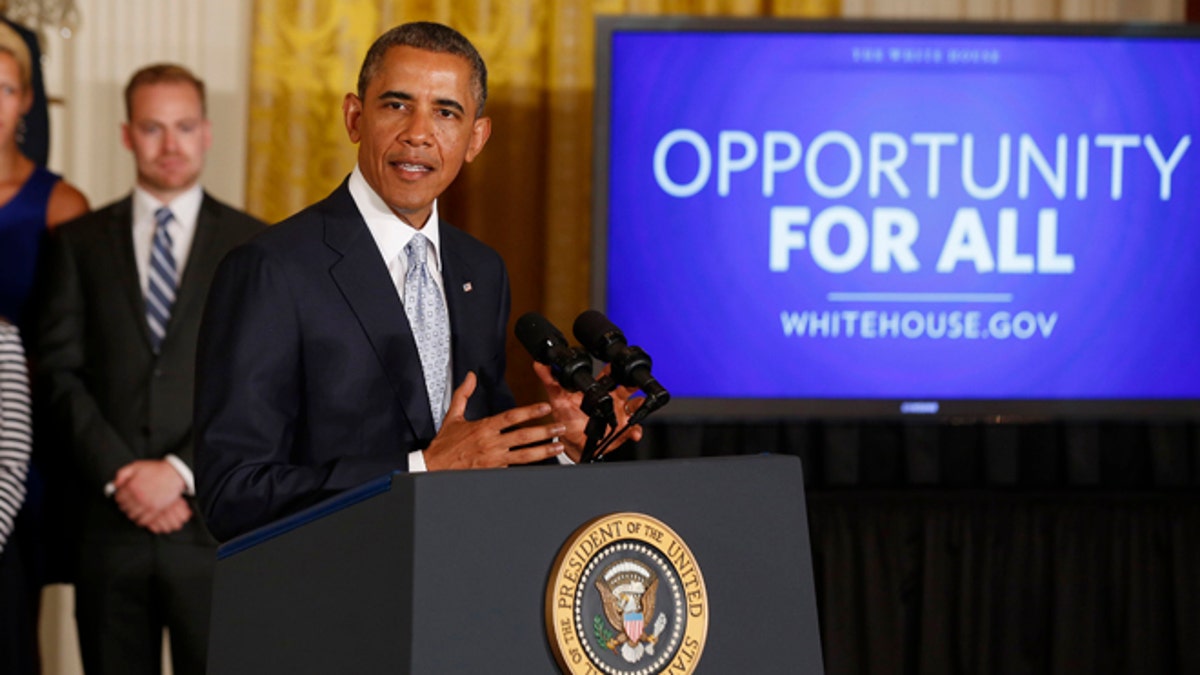
June 9, 2014: President Obama speaks before he signs a presidential memorandum on reducing the burden of student loan debt in the East Room of the White House. (Reuters)
The cost of President Obama's student loan forgiveness program has ballooned by nearly $22 billion over initial projections, raising alarm among budget hawks -- even as the government promises taxpayers eventually will come out ahead.
The figure was included in Obama's recently released budget proposal.
In budget-speak, the Department of Education summary said: "The 2015 amount includes a net upward reestimate of $21.8 billion, primarily related to revised interest rates and increased participation in income-driven repayment plans."
In other words, swelling enrollment due to looser loan rules is driving up costs -- a lot.
Critics point to recent changes in the program. Among them was the PAYE, or Pay As You Earn, program allowing students to cap loan payments at 10 percent of their incomes. It was the result of legislation Congress passed and Obama signed in 2010. The law also allows for loan forgiveness after 20 years of payments, and after 10 years for those in "public service" -- a broad category that includes government and nonprofit workers.
"They didn't account for the market risk in making these loans," said Romina Boccia, a budget fellow at the conservative Heritage Foundation.
In 2013, 124,000 people enrolled in the PAYE plan. A year later, Obama directed the secretary of education to propose regulations to potentially cap loans for another 5 million people. The loan program changes and expansions tacked on the extra $22 billion to the price tag.
The number pales in comparison to total student debt. All told, Americans have $1.13 trillion in student loans outstanding, according to the most recent data from The Federal Reserve Bank of New York.
Average Student Debt by State | FindTheBest!function(d,s,id){var js,fjs=d.getElementsByTagName(s)[0],p=/^https:/.test(d.location)?'https':'http';if(!d.getElementById(id)){js=d.createElement(s);js.id=id;js.src=p+"://cdn1.findthebest.com/rx/widgets.js";fjs.parentNode.insertBefore(js,fjs);}}(document,"script","ftb-widgetjs");
A White House Office of Management and Budget official told FoxNews.com that "revisions are not uncommon." The office countered claims that there is a "shortfall," as some other media outlets have reported. Essentially, the program expanded and the budget office accounted for that expansion over the entire life of the program.
The official touted benefits to taxpayers, claiming the changes help students avoid default and even strengthen the economy.
OMB and the nonpartisan Congressional Budget Office maintain that the federal government will make money over the life of the loans. That's because, they say, even after accounting for anticipated defaults, the government borrows money at a much cheaper rate than the interest it charges to borrowers of student loans.
Others aren't so confident taxpayers will come out ahead.
It's "hard to see how this is going to come out as a net positive as the administration predicts," said Steve Ellis, with Taxpayers for Common Sense.
The budget watchdog group has welcomed past reforms the government has made regarding student loans, but is watching this situation closely to see whether it is a one-time budget hit, as the OMB contends, or an ongoing problem.
Ellis wants to make sure the loan forgiveness program meets Americans' priorities.
"Is it too generous?" Ellis asks. "Is it hitting the right people?"
Boccia contends the government should view risk the way private lenders would, something known as Fair Value Accounting.
The government doesn't use Fair Value Accounting, but rather follows the Federal Credit Reform Act of 1990, or FCRA, when making projections. It has found those numbers more accurate, because unlike a bank, the federal government doesn't need to turn a profit and is better able to diversify.
Lindsey Burke, an education fellow at the Heritage Foundation, sees a problem.
"Somebody pays for that loan forgiveness," Burke said. "And that is the three-quarters of Americans who don't have bachelor's degrees themselves."
The subsidies also may be driving up the cost of education, a concept known as The Bennett Hypothesis (after President Reagan's Education Secretary William Bennett), which Burke believes drives "the vicious lending and spending cycle." It's evident that education costs have risen, but studies on the effects of subsidies are tougher to tease out.
The Obama administration has promised it is working on slowing the soaring costs, for instance, by showing prospective borrowers what they're getting for their money.




